The effects of camel chymosin and Withania coagulans extract on camel and bovine milk cheeses
- PMID: 34193923
- PMCID: PMC8245653
- DOI: 10.1038/s41598-021-92797-6
The effects of camel chymosin and Withania coagulans extract on camel and bovine milk cheeses
Abstract
Withania coagulans (W. coagulans) extract and camel chymosin have aspartic protease capable of coagulating milk for cheese production. This study investigated the quality of camel and bovine milk cheeses coagulated using Withania extracts, came chymosin, and their mixture in two experiments. In Experiment (1), a factorial design with four factors (W. coagulans, camel chymosin, incubation time, and incubation temperature) was performed. The effect of these factors on cheese's yield and hardness were assessed. An enzyme concentration corresponding to a 36 µg/L of milk of W. coagulans, 50 IMCU/L of camel chymosin, holding time of 4 h, and incubation temperature of 60 °C provided the optimal textural hardness for both camel and bovine milk cheeses. Seven treatments were analyzed in experiment (2) were analyzed for physicochemical properties, yield, and sodium dodecyl sulfate-polyacrylamide gel electrophoresis (SDS-PAGEitation). The results showed that pure Withania extract exhibited the lower coagulating effect resulting in cheeses with low yield, hardness, fat, protein, and total solids. The SDS-PAGE electropherograms of camel cheese showed several low molecular weight bands as compared to bovine cheese. This phenomenon is due to excessive proteolysis in camel cheese, which we believed is caused by the presence of endogenous enzymes.
Conflict of interest statement
The authors declare no competing interests.
Figures
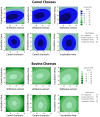
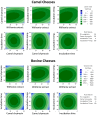
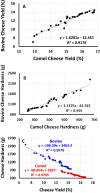
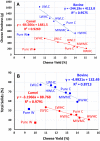
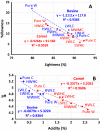


Similar articles
-
The Texture of Camel Milk Cheese: Effects of Milk Composition, Coagulants, and Processing Conditions.Front Nutr. 2022 Apr 19;9:868320. doi: 10.3389/fnut.2022.868320. eCollection 2022. Front Nutr. 2022. PMID: 35520282 Free PMC article. Review.
-
Using recombinant camel chymosin to make white soft cheese from camel milk.Food Chem. 2021 Feb 1;337:127994. doi: 10.1016/j.foodchem.2020.127994. Epub 2020 Sep 5. Food Chem. 2021. PMID: 32919273
-
Effect of camel chymosin on the texture, functionality, and sensory properties of low-moisture, part-skim Mozzarella cheese.J Dairy Sci. 2014;97(1):85-96. doi: 10.3168/jds.2013-7081. Epub 2013 Nov 13. J Dairy Sci. 2014. PMID: 24239084
-
Effects of Pasteurization and High-Pressure Processing of Camel and Bovine Cheese Quality, and Proteolysis Contribution to Camel Cheese Softness.Front Nutr. 2021 Jun 17;8:642846. doi: 10.3389/fnut.2021.642846. eCollection 2021. Front Nutr. 2021. PMID: 34222297 Free PMC article.
-
Rennet Coagulation and Cheesemaking Properties of Thermally Processed Milk: Overview and Recent Developments.J Agric Food Chem. 2015 Nov 4;63(43):9389-403. doi: 10.1021/jf504167v. Epub 2015 Mar 10. J Agric Food Chem. 2015. PMID: 25607716 Review.
Cited by
-
Incubating Green Synthesized Iron Oxide Nanorods for Proteomics-Derived Motif Exploration: A Fusion to Deep Learning Oncogenesis.ACS Omega. 2022 Dec 12;7(51):47996-48006. doi: 10.1021/acsomega.2c05948. eCollection 2022 Dec 27. ACS Omega. 2022. PMID: 36591177 Free PMC article.
-
Camel Milk: Antimicrobial Agents, Fermented Products, and Shelf Life.Foods. 2024 Jan 24;13(3):381. doi: 10.3390/foods13030381. Foods. 2024. PMID: 38338516 Free PMC article. Review.
-
The Texture of Camel Milk Cheese: Effects of Milk Composition, Coagulants, and Processing Conditions.Front Nutr. 2022 Apr 19;9:868320. doi: 10.3389/fnut.2022.868320. eCollection 2022. Front Nutr. 2022. PMID: 35520282 Free PMC article. Review.
-
Profiling protein hydrolysis and amino acid metabolism in camel and bovine milk fermented by Lactobacillus helveticus, L. bulgaricus, and Streptococcus thermophilus.Sci Rep. 2025 May 26;15(1):18371. doi: 10.1038/s41598-025-02944-6. Sci Rep. 2025. PMID: 40419683 Free PMC article.
-
Effect of Freeze-Dried Camel Rennet Extract on Coagulation of Camel-Goat Milk Mixture and Characterization of the Cheese Obtained.Foods. 2025 Jan 21;14(3):334. doi: 10.3390/foods14030334. Foods. 2025. PMID: 39941927 Free PMC article.
References
-
- Faostat, F. Available online: http://www.Fao.org/faostat/en/#data. QC (accessed on January 2018) (2017).
-
- Technavo. Camel Milk Products Market Size, Industry Report, 2020–2027. Market Analysis Report, 80. GVR-4-68038-430-7 (2020).
-
- Solanki D, Hati S. Fermented camel milk: A review on its bio-functional properties. Emirates J. Food Agric. 2018;30:268–274. doi: 10.9755/ejfa.2018.v30.i4.1661. - DOI
-
- Bornaz S, Sahli A, Attalah A, Attia H. Physicochemical characteristics and renneting properties of camels’ milk: a comparison with goats’, ewes’ and cows’ milks. Int. J. Dairy Technol. 2009;62:505–513. doi: 10.1111/j.1471-0307.2009.00535.x. - DOI
Publication types
MeSH terms
Substances
LinkOut - more resources
Full Text Sources

